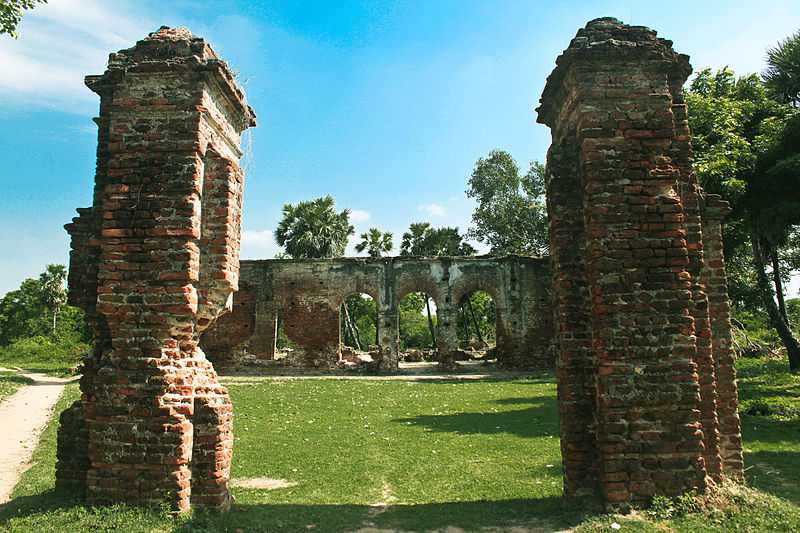
History and Archaeological Importance
Arikamedu was initially a fishing town and was later converted into a harbor town made up of bricks. This happened as the trade started to develop. At present, one can find the remains of the so-called famous port city.
In addition to maritime commerce, the city also carries out its domestic trade with Kaveripattinam, Alagankulam, Musiri and Suttukeni. Imports in the port town include wines contained in amphora jars, cups and plates made up of red roman clay pots, olive oil, and ceramic products.
Discovery of the site
In around 1760-65, a French astronomer named Le Gentil (short of quite a mouthful of a typical French name Joseph Hyacinthe Jean-Baptiste Le Gentil de la Galaisière) visited the site of Arikamedu quite by chance. He was supposed to witness a cosmic event, the transition of Venus, a once in a many years occurrence, right in Pondicherry which was then a French colony.
It was during this time that the old structure was noticed by the astronomer, the ruins of centuries-old bricks and walls, and he was quite sure that they belonged to an ancient town or village which was once prosperous. It was eventually found out that the officials of French East India Company had uncovered a site with old bricks and had mentioned it in one of their documents to their authorities, but that was much later. And in any case, that particular report did not induce any effort from the French to identify the site.
Excavations of the site
It seems like the ancient mart area of Arikamedu loves to evade public attention. Next, it came into prominence is in 1940, almost two centuries later, when resident French Indologist Gabriel Jouveau Dubreuil. He found some gemstones and other trinkets from the local boys and also intaglio which had a man's face carved on whom he identified as the Roman emperor Augustus Caesar. Added with a couple of more findings like beads, the same kind found in the seaports of Red Sea, and he could identify the place as Poduke, the region mentioned in the Periplus Maris Erythraei. It is a comprehensive account of the maritime trade details and routes of the Roman Empire along the Red Sea and in the Indian Ocean.
Scientific excavations began in 1945 by Sir E. R. Mortimer Wheeler, the then director of ASI, and a good many artefacts were recovered from the ruins. Glass items, jars, gemstones, expensive cutleries, none that matched the current livelihood of the local people. Later, more digging was done by Jean-Marie Casal from 1947 to 1950 after the war, who determined that the site belonged to a Megalithic period from burial marks on epitaph stones close by.
Findings
All the various excavations over the years have brought forward many small and big artefacts, some of them dishevelled and some of them in good enough shape for identification of date and origin. Among the bottom layers of the excavation, certain ancient pottery artefacts were unearthed. Amphorae - the pink wine jars with a narrow neck, two handles and a yellow slip, and Arretine ware - utensils made of burnt clay and relief on them. Both of these are Samian wares or Terra Sigillata which were in manufacture and use along the Mediterranean in between 100 BCE to 50-100 CE and found in only two places out of the then area of Roman Empire.
Arikamedu is one of them, thus proving ancient Roman ties. Gold beads, Roman lamps and glasses, Greco-Roman semi-precious gems were also found here. According to Mortimer's report, early trade was done only till around 2nd century CE. But in the middle layers, they found coins that were minted by Constantine 1 and were in circulation till about 700 CE.
In the uppermost layers, the archaeologists found some items of Chola dynasty and some of the middle-eastern and Chinese origin as well, thus proving Jean-Marie's conclusion. Folklore says there were so many riches that you can still find shiny beads on the ground when it rains, but probably it is all a legend.
What to expect while visiting Arikamedu
Much of what was actually there was already gone by the time Le Gentil found the structure. It is even more in ruins now after the repeated excavations. What was once a bustling marketplace for exchanging the riches of Orient and Occident, now stands as a derelict structure like an abandoned place. The area has a basic perimeter fenced by the Archaeological Survey of India, but it is not under their direct protection and maintenance as of yet.
The main site is a few minutes' walk from the gate of the fence. There are two columns of Roman bricks which are assumed to be the gate and beyond that lie the remains of a structure which the experts have presumed to be a storehouse based on architecture and structure. The area around is all green, typical to the scenery of Tamil Nadu, lined with coconut and palm trees on both sides.
You might find two different types of brick structure in the place. This is because in the 1770s, a French missionary, Monsieur Pigneau de Behaine, designated Bishop of Adran, built a seminary and residence for the Jesuit refugees of Siam. It was abandoned by 1783, but some of the remains of the renovations done by the French remain here, mixed with the earlier ones.
Best time to visit Arikamedu
The best time to visit Arikamedu when the climate is very pleasant is during the months extending from October to March.
How to Reach Arikamedu
The site might not be on the map routes of the travel agencies because it is a not frequently-visited place at all. So hire a car for this purpose separately if you want to. If the driver does not know the exact location, you can use GPS to guide him. It is only 4 kilometres from Pondicherry and will not take long, but locating the spot of the gate might be a task.
Top Tourist Places in Pondicherry
Auroville Ashram
Water Sports in Pondicherry
Scuba Diving in Pondicherry
Seaside Promenade
Chunnambar Boat House
Basilica of the Sacred Heart of Jesus
All Tourist Places in Pondicherry
Tips
No accommodation facilities are available in Arikamedu. Also, there are not many eating outlets there so one must carry along food package as well as water bottles to the place.
Photos of Arikamedu
Comments on Arikamedu
Post Your Comment















